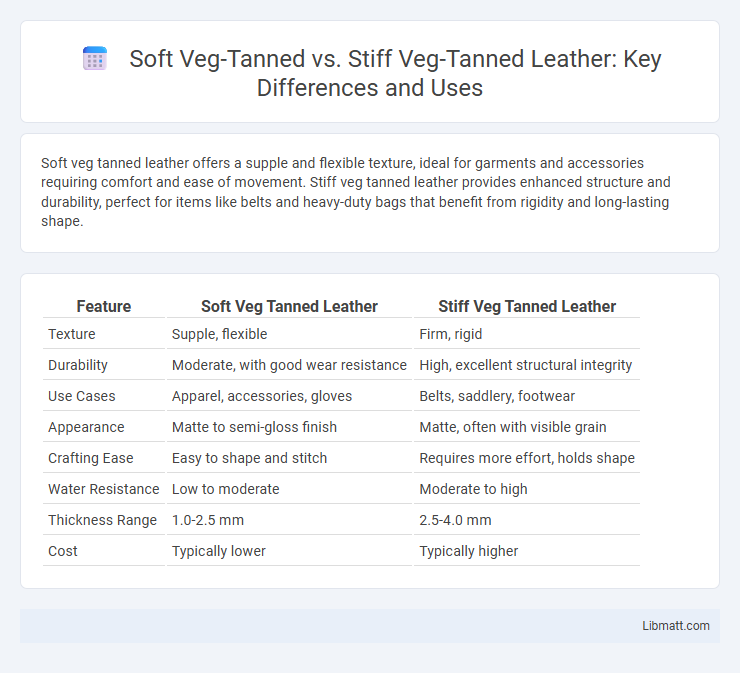Soft veg tanned leather offers a supple and flexible texture, ideal for garments and accessories requiring comfort and ease of movement. Stiff veg tanned leather provides enhanced structure and durability, perfect for items like belts and heavy-duty bags that benefit from rigidity and long-lasting shape.
Table of Comparison
| Feature | Soft Veg Tanned Leather | Stiff Veg Tanned Leather |
|---|---|---|
| Texture | Supple, flexible | Firm, rigid |
| Durability | Moderate, with good wear resistance | High, excellent structural integrity |
| Use Cases | Apparel, accessories, gloves | Belts, saddlery, footwear |
| Appearance | Matte to semi-gloss finish | Matte, often with visible grain |
| Crafting Ease | Easy to shape and stitch | Requires more effort, holds shape |
| Water Resistance | Low to moderate | Moderate to high |
| Thickness Range | 1.0-2.5 mm | 2.5-4.0 mm |
| Cost | Typically lower | Typically higher |
Introduction to Vegetable Tanning
Vegetable tanning uses natural tannins from tree bark and other plant sources to transform raw hides into durable leather. Soft veg tanned leather undergoes a controlled tanning process with flexible organic compounds, resulting in a supple, pliable texture ideal for wallets and garments. In contrast, stiff veg tanned leather features a denser tannin concentration, providing enhanced rigidity and structural integrity suited for belts, saddles, and heavy-duty accessories.
What is Soft Veg Tanned Leather?
Soft vegetable tanned leather is crafted using natural tannins extracted from tree bark and plants, resulting in a flexible and pliable material. Unlike stiff vegetable tanned leather, it undergoes a specialized tanning and conditioning process that preserves softness while maintaining durability and breathability. This type of leather is ideal for products requiring comfort and ease of movement, such as gloves and apparel.
What is Stiff Veg Tanned Leather?
Stiff vegetable-tanned leather is a type of leather processed using natural tannins extracted from plant materials such as tree bark, resulting in a firm and rigid texture. This leather is characterized by its durability, ability to hold shape, and minimal flexibility, making it ideal for applications like belts, saddles, and structured bags. The tanning process typically takes several weeks, producing leather that becomes more stiff and robust compared to soft vegetable-tanned leather, which is treated to retain suppleness and flexibility.
Key Differences: Soft vs Stiff Veg Tanned
Soft vegetable tanned leather offers greater flexibility and a supple feel, making it ideal for garments and accessories that require comfort and movement. Stiff vegetable tanned leather provides a firm structure, excellent for items like belts and holsters where durability and shape retention are crucial. Understanding these key differences helps you select the right leather type based on your project's texture and functional needs.
Tanning Process: How Texture is Determined
Soft veg tanned leather is achieved through a controlled vegetable tanning process that uses shorter soaking times and precise hydration levels, resulting in a supple, flexible texture. In contrast, stiff veg tanned leather undergoes prolonged exposure to natural tannins, creating a denser, firmer material with minimal plasticizers or oils added. Understanding these variations in your leather's tanning process allows you to select the ideal texture for comfort or durability in your leather goods.
Common Uses for Soft Veg Tanned Leather
Soft vegetable tanned leather is prized for its flexibility and breathability, making it ideal for crafting gloves, wallets, and apparel that require a comfortable fit. Your choice of soft veg tanned leather enhances products like handbags and shoes by providing durability without stiffness. This leather type balances strength and softness, catering to accessories that benefit from a supple, natural feel.
Typical Applications of Stiff Veg Tanned Leather
Stiff vegetable-tanned leather is commonly used for applications that require durability and structure, such as belts, saddles, holsters, and heavy-duty footwear. Its firmness provides excellent support and shape retention, making it ideal for products subjected to regular wear and tear. You benefit from the leather's natural rigidity when crafting items that demand strength and longevity.
Durability and Aging: Soft vs Stiff
Soft veg tanned leather offers greater flexibility and a more supple feel, which allows it to develop a natural patina and age gracefully with use. Stiff veg tanned leather, while less flexible initially, provides superior durability and structural support, often resulting in a longer lifespan for heavy-duty applications. Your choice depends on whether you prioritize immediate comfort and a softer look or long-term strength and rugged aging.
Care and Maintenance Tips
Soft veg tanned leather requires regular conditioning with natural oils or leather balms to maintain its supple texture and prevent drying or cracking. Stiff veg tanned leather benefits from occasional light moisturizing and gentle flexing to retain rigidity without becoming brittle. Both types should be kept away from excessive moisture and direct sunlight to preserve their quality and longevity.
Choosing the Right Veg Tanned Leather
Soft veg tanned leather offers flexibility and a supple feel, making it ideal for garments and accessories requiring comfort and ease of movement. Stiff veg tanned leather provides durability and structure, perfect for items like belts, tool holsters, or footwear that need to maintain shape and support. Understanding your project's requirements for flexibility or rigidity helps you choose the right veg tanned leather to ensure longevity and performance.
Soft veg tanned vs stiff veg tanned Infographic

 libmatt.com
libmatt.com